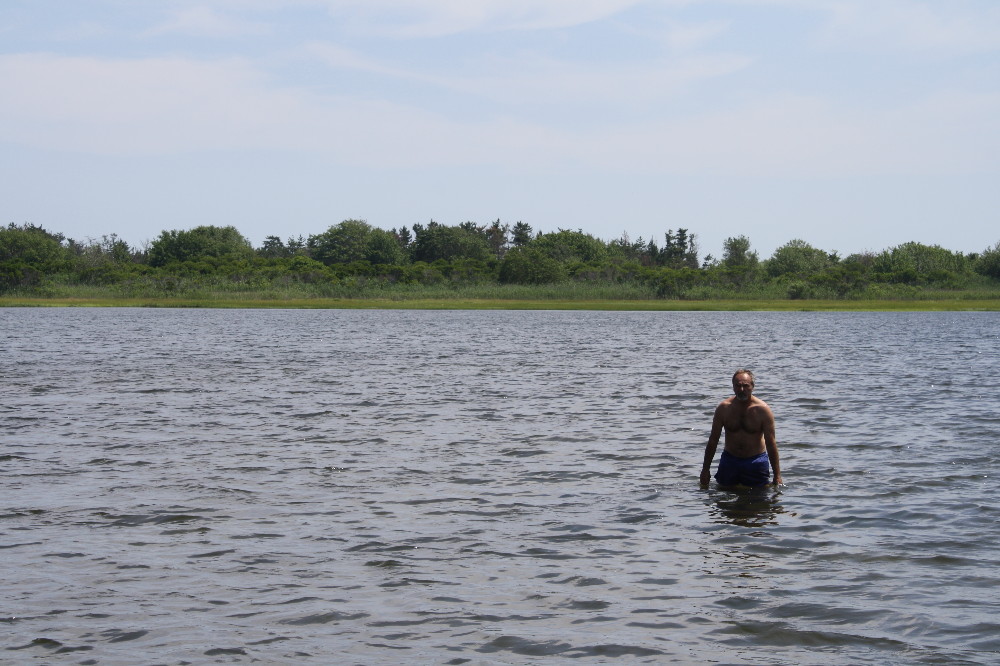 |
| Clamming on the south shore of Long Island, NY |
During our recent hiatus from blogging at the beginning of July, we spent some of our time on vacation on Long Island. For me and my family, life on the island frequently revolves around the water. Each season has its own character: the desolate, wind-swept beaches of winter; the frigid water and good waves of spring; the crowds of summer; the approach of late summer / early fall hurricane season and more good waves.
Within the seasons there are also micro-seasons, each timed by the ocean and her annual evolution. Snapper season. Bluefish season. When the striped bass are running. Crabbing season. And clamming season.
Each has its own appeal. Clamming, for instance, is a visceral, tactile, intimate experience. Whereas with fishing or crabbing you might use a rod and reel, or net, or trap, with clamming—at least as my family practices it—it’s just you and the clams.
We take a boat to an unnamed cove on the south shore of the island, where a narrow strip of barrier beaches protect the bay from the harsher waters of the open Atlantic. In this sandy-bottomed cove, lined with saltwater marsh grasses, the bottom is soft. You walk through the water methodically, wriggling your feet into the sand, feeling for the unmistakeable edge of a clam shell.
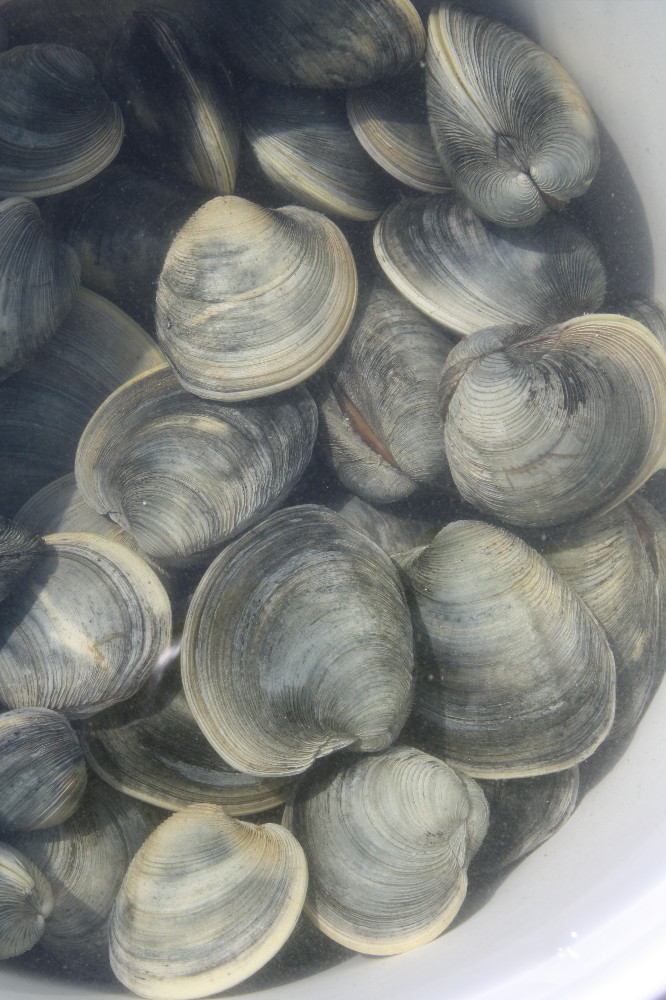 |
| The harvest |
Sometimes, instead of the smooth edge of a clam shell, you feel something sharp. As my Uncle Joe says, when that happens, withdraw your foot and move on. Rarely does further exploration end well. As I can personally attest, doing so may result in an unpleasant encounter with a crab, who will do one of two things: swim away or draw blood.
Finding a clam is moment of uncertainty and promise. Will it be a keeper? One to return to the sand? Some are too small. Some are too big. (Hard shell clams—also known as quahogs—are classified by their size, from little necks on the smaller end, to cherry stones, to chowder clams on the larger end.) And frankly, some just aren’t good enough to make the cut. Some have shells that are clearly compromised … whether through calcification, or damage, or whatever. Often, a rough-looking shell on the outside holds less-than-pristine meat on the inside. The best clams, I’ve learned, are ones with what Uncle Joe calls the “white smile,” a lip of bright shell around the outer edge opposite the hinge. They tend to hold beautiful meat, with a shell interior of pearly white with a patch of beautiful deep purple at the back near the hinge.
This is a subtle understanding of clamming gleaned—not through years or even decades—but through a lifetime spent on and in the water. It is insight and knowledge inherited and passed on, first to my generation (to me and my cousins and brother and our significant others), and eventually, to my daughters’ generation.
But the knowledge starts with my Uncle. Sometimes explicitly, and sometimes in subtler ways, he is present in many of the recipes and blog posts we write … particularly ones that have to do with the ocean and seafood. Witness our foil packet blackfish. Whether he would accept the title or not, he is a patriarch of the family. And at the very least, he’s an important influence on my—and our—love of the ocean and seafood.
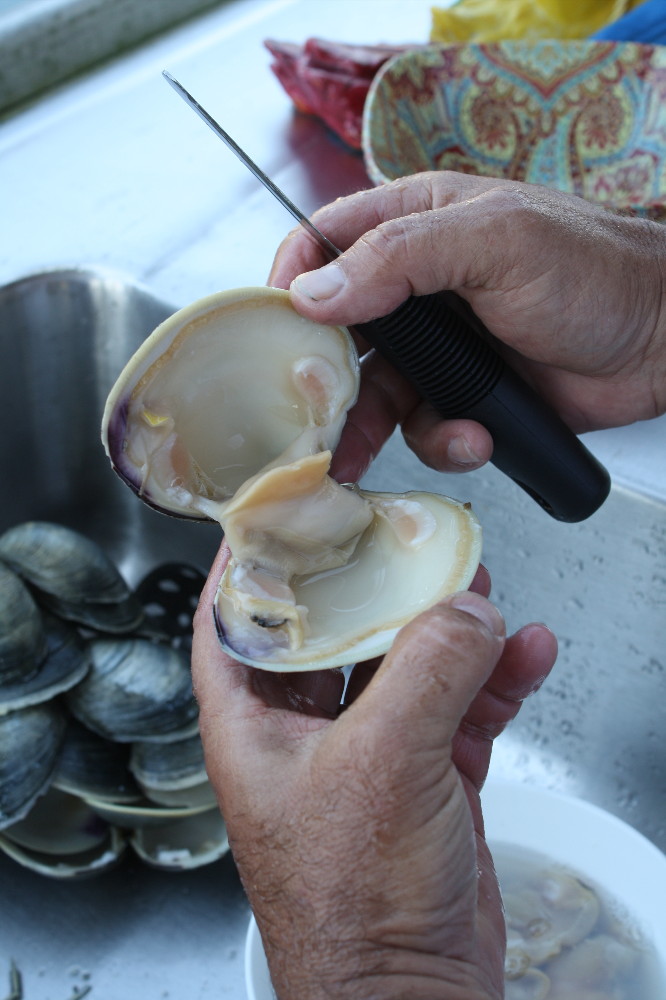 |
| It doesn’t get any fresher than this |
This way of connecting generations of family through food remains as important to me as ever. It’s a theme I’ve returned to many times, whether in this post or in our recipe for speculaas cookies, passed down from the 19th century through present day from the Belgian side of my family. This theme is also at the core of Artisanal Gluten-Free Cooking, which is now out in its second edition.
I have always sought family permission before sharing recipes and stories such as these. Part of me has at times felt conflicted about doing so. Am I giving away a part of my heritage? Am I compromising privileged information for the sake of a blog post or a cookbook recipe? To their credit, our family has supported the decision to share such recipes.
I think that’s because heritage is as important to them as it is to me, and they see the value in sharing that message with readers. Dietary restrictions can threaten to sever you from your food heritage and your family. I hope, though, that you are inspired to maintain the connection, or to reconnect. Even if you approach old foods and old recipes with new ingredients or a new perspective (say, to make a healthier version of a beloved treat), the point is to stay connected to those foods. They feed the body, but they also feed the soul.
But back to the clams…
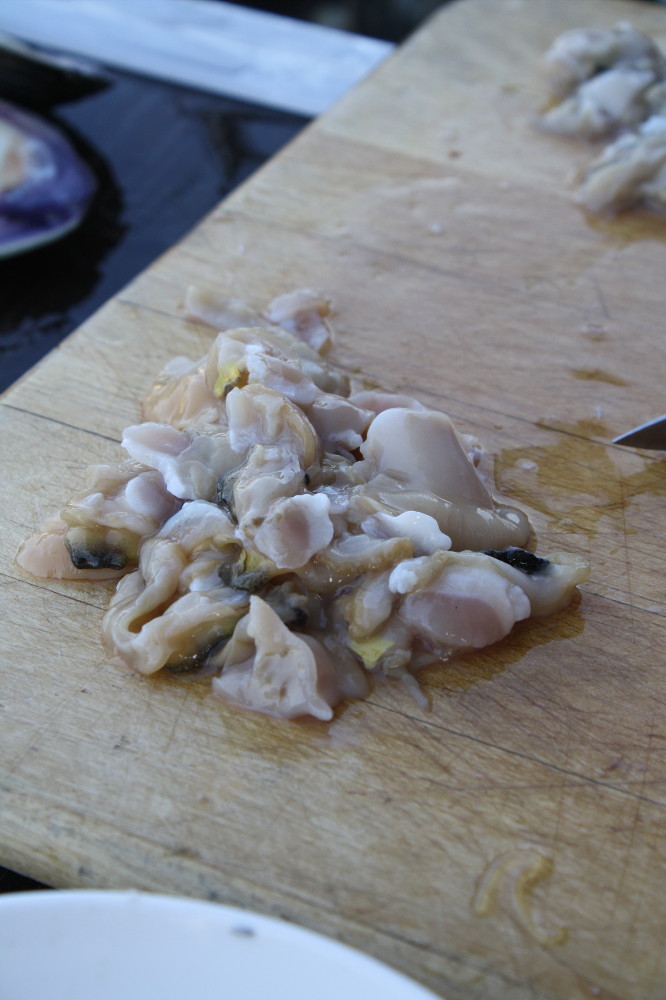 |
| The added time and effort to separate the best meat is well worth it |
With my Uncle’s strict quality-control clam standards (and believe me, the exceptional results later more than justified those standards), it seemed like we kept only 1 out of every 3 clams we found. Even so, we had more than enough to feed all who were there for the clam bake. With our harvest complete, we retired to his friend’s house on a nearby canal. Then the real work began.
We placed the clams on ice for a while. This relaxes their muscles, making the job of shucking much easier. (Some websites suggest popping them in a hot oven briefly to get them to start to open, but this prematurely begins to cook the clams, which will get chewy). Then Uncle Joe masterfully went about the work of shucking our harvest: using a clam knife to cut each of two adductor muscles that keep the clam closed, opening the shell, reserving the clam juice, and separating the meat from the shell. I can tell that I have many years of clam shucking ahead of me before I reach his level of proficiency… This time around I simply watched and learned from a master.
Then he did something that few people do, in my experience. Though you can eat the entire clam, he took extra time to cut away the digestive tract, reserving only the choicest parts of the clam meat. He also separated all that choice meat from their respective shells. (The reason why will soon be revealed…)
At last, it was time to make what we had all been looking forward to: clams oreganata, an Italian dish where clams on the half shell are lightly covered with seasoned bread crumbs and baked in the oven. They are sometimes served with a wedge of lemon to squeeze over the clams, though as my family prepares them I’ve seldom found the lemon necessary.
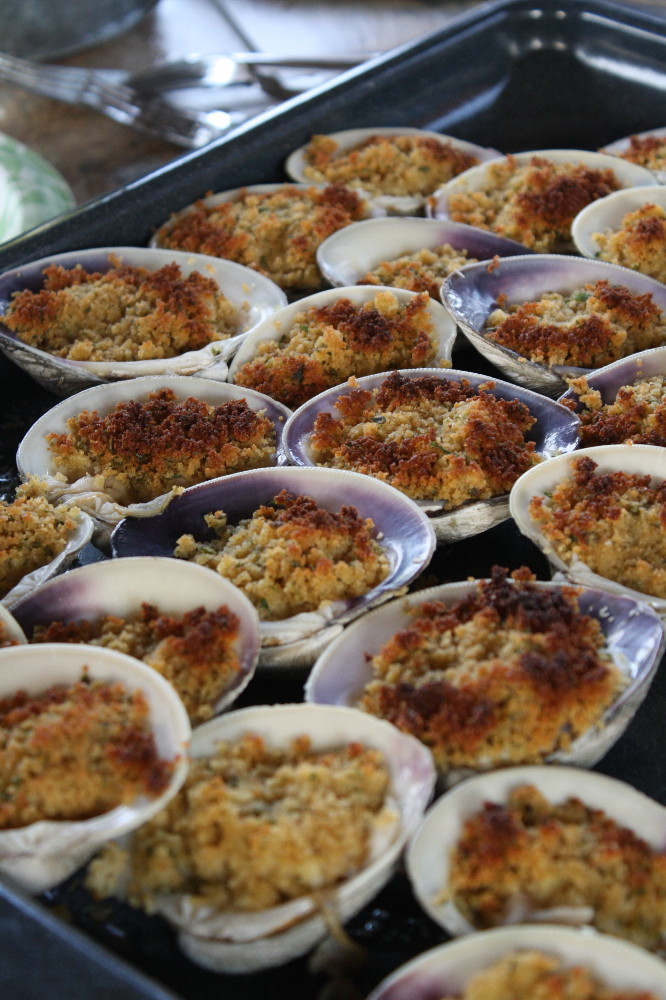 |
| The finished product |
We combined Italian-seasoned gluten-free bread crumbs, some minced garlic, and a bit of olive oil. Meanwhile, we laid out shells on a baking sheet while an oven preheated to 350 deg F or so. Then, from his stash of choice clam meat, Uncle Joe portioned an equal quantity of clam into each shell. (This circumvents the problem of larger and smaller clams cooking at different rates, resulting in some that are overcooked and others that aren’t cooked enough.) Each clam gets a small splash of clam juice, gets topped with some bread crumbs, then another light splash of clam juice.
Next, the recipe gets “intuitive.” Place the clams on the middle rack of the oven, and after a few minutes, begin to monitor them closely. Crack the oven door and listen for a faint hissing. That’s the sound of the clam juice boiling and steaming the meat. I can’t give you a hard and fast time. You just need to learn through practice, as I’m still doing. When you do hear that noise, though, switch your oven to broil and continue to watch the clams closely. When the bread crumbs are golden brown, the clams are done. It’s time to enjoy the fruits of your labor. (And believe me, it does involve labor if you undertake this entire process on your own. Better to have a team share the effort, or best, to have an Uncle Joe.)
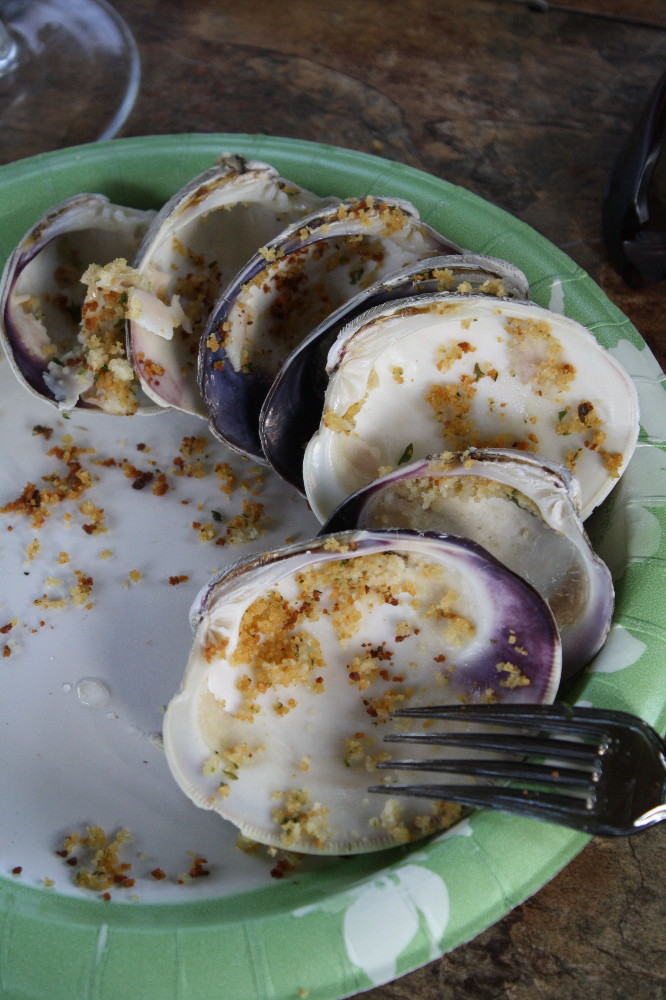 |
| The product, finished |
We sat in the backyard with glasses of white wine, a light breeze, and a late-day sun. We dined on some of the best clams oreganata—gluten-free or not—I’ve ever had. This wasn’t just my own nostalgia for the food kicking in. By the reaction from Kelli—who doesn’t have the same memories or childhood experiences I did of a day and a dish such as this—the clams were objectively exceptional.
It was the kind of meal that was deeply satisfying. It nourished body and soul. It was born of a day of “labor” under a summer sun. It was a communal experience, the result of shared effort. And it was gluten-free.
Whether you make this dish one day or not—and I recognize that few people will go to the length of harvesting their own clams—do me this favor: write your own real-life clams oreganata story. Collect a harvest from your garden, or carefully select fresh ingredients at your local market. Get together with your significant other, or friends, or family. Work together to make a special meal that everyone can enjoy. Share that meal; share conversation. Connect it back to your heritage, no matter if that heritage is regional, or cultural, or spiritual. Nourish your body and your soul.
That, in a way, is a kind of recipe, too. It’s one that translates across cultures, across foods, across dietary restrictions.
–Pete
What a beautiful article and those clams look just delicious! I’m originally from New England and clams are considered something special in my family.
I agree with you about family traditions not being lost because of being a celiac and being GF. I told you on the Gluten Dude’s site and I’ll tell you again—you guys “saved” Thanksgiving (which is also my birthday) as your pie crust is about as close to my Gramma and Mom’s as it gets. Apple pie was also my birthday “cake” my entire life and I was very upset to think I would never enjoy a flaky pie crust ever again. So Thank you !! for sharing so much of yourselves with the world. I love your Artisinal GF Cooking cookbook.
I am working on some traditional Armenian recipes to convert. My paternal grandparents came to this country from Armenia and I have mastered a good lamejun (Lamb meat pie) using my Gramma’s handwritten directions for the filling…but baklava? oh man, phyllo dough is not easy. May be a while before I get that one right.
Love your blog. Glad I found it!
Cheers!
Hi IrishHeart,
Thanks for your compliments! Very exciting about converting traditional Armenian recipes. And ah yes…phyllo dough. That’ll be a tough one! We’ve contemplated trying to do it, but haven’t attempted yet. =)
Cheers, Pete
Fabulous story ever! I love reading your article sounds healthy. Fantastic pics! What a wonderful gluten free awesome site. Thanks for this info! I keep on reading…
That looks delicious!
Thank you for sharing the recipe.